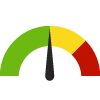Indicator Gauge Icon Legend
Legend Colors
Red is bad, green is good, blue is not statistically different/neutral.
Compared to Distribution
 the value is in the best half of communities.
the value is in the best half of communities.
 the value is in the 2nd worst quarter of communities.
the value is in the 2nd worst quarter of communities.
 the value is in the worst quarter of communities.
the value is in the worst quarter of communities.
Compared to Target
 meets target;
meets target;  does not meet target.
does not meet target.
Compared to a Single Value
 lower than the comparison value;
lower than the comparison value;
 higher than the comparison value;
higher than the comparison value;
 not statistically different from comparison value.
not statistically different from comparison value.
Trend

 non-significant change over time;
non-significant change over time; 
 significant change over time;
significant change over time;  no change over time.
no change over time.
Compared to Prior Value
 higher than the previous measurement period;
higher than the previous measurement period;
 lower than the previous measurement period;
lower than the previous measurement period;
 no statistically different change from previous measurement period.
no statistically different change from previous measurement period.
 Significantly better than the overall value
Significantly better than the overall value
 Significantly worse than the overall value
Significantly worse than the overall value
 No significant difference with the overall value
No significant difference with the overall value
 No data on significance available
No data on significance available
Opioid Treatment Admission Rate
This indicator is archived and is no longer being updated. Click to learn more
Why is this important?
Opioids are natural or synthetic chemicals that bind to receptors in your brain or body. Common opioids include heroin and prescription drugs such as oxycodone, hydrocodone, and fentanyl. Opioid abuse is a serious public health issue, but preventive actions, treatment for addiction, and proper response to overdoses can help.
The majority of drug overdose deaths involve an opioid, and at least half of all opioid overdose deaths involve a prescription opioid. Since 1999, the rate of overdose deaths involving opioids (including prescription opioid pain relievers and heroin) nearly quadrupled. We now know that overdoses from prescription opioid pain relievers are a driving factor in the increase in opioid overdose deaths. (Centers for Disease Control and Prevention)
County: Warren
Measurement period: 2022
Maintained by: Conduent Healthy Communities Institute
Last update: February 2024
Graph Selections
| County | Source | Measurement Period | Admissions per 100,000 population | |
|---|---|---|---|---|
Data Source
- State of New Jersey Department of Human Services, Division of Mental Health and Addiction Services
Maintained By: Conduent Healthy Communities Institute (Methodology)
Filed under: Health / Alcohol & Drug Use, Clinical Care



